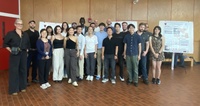Abstract:
Mechanotransduction refers to the conversion of mechanical forces into biochemical or electrical signals that initiate structural and functional remodeling in cells and tissues. The heart is a kinetic organ whose form changes considerably during development and disease, requiring cardiac myocytes to be mechanically durable and capable of fusing a variety of environmental signals on different time scales. During physiological growth, myocytes adaptively remodel to mechanical loads. Pathological stimuli can induce maladaptive remodeling. In both of these conditions, the cytoskeleton plays a pivotal role in both sensing mechanical stress and mediating structural remodeling and functional responses within the myocyte.
